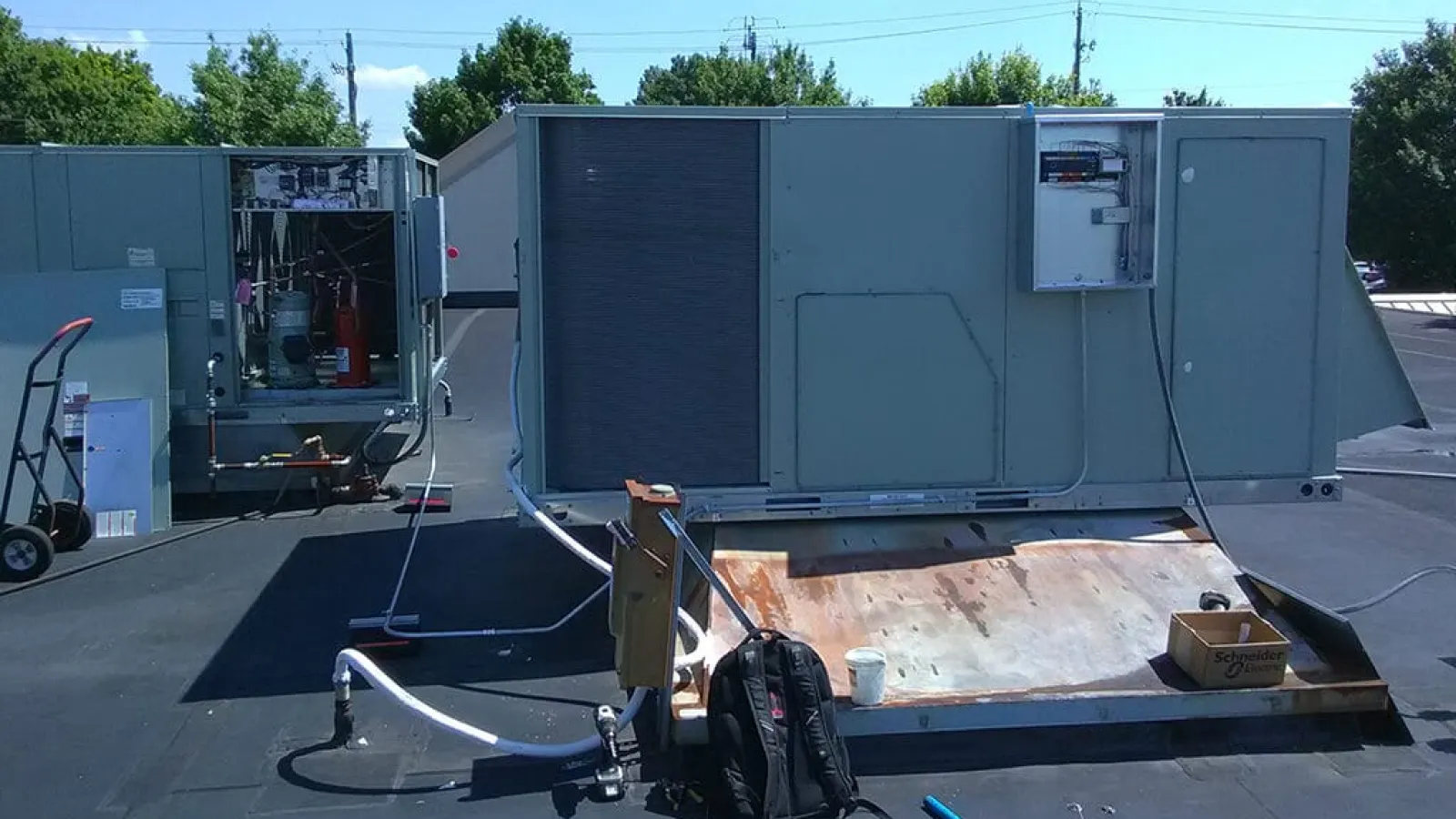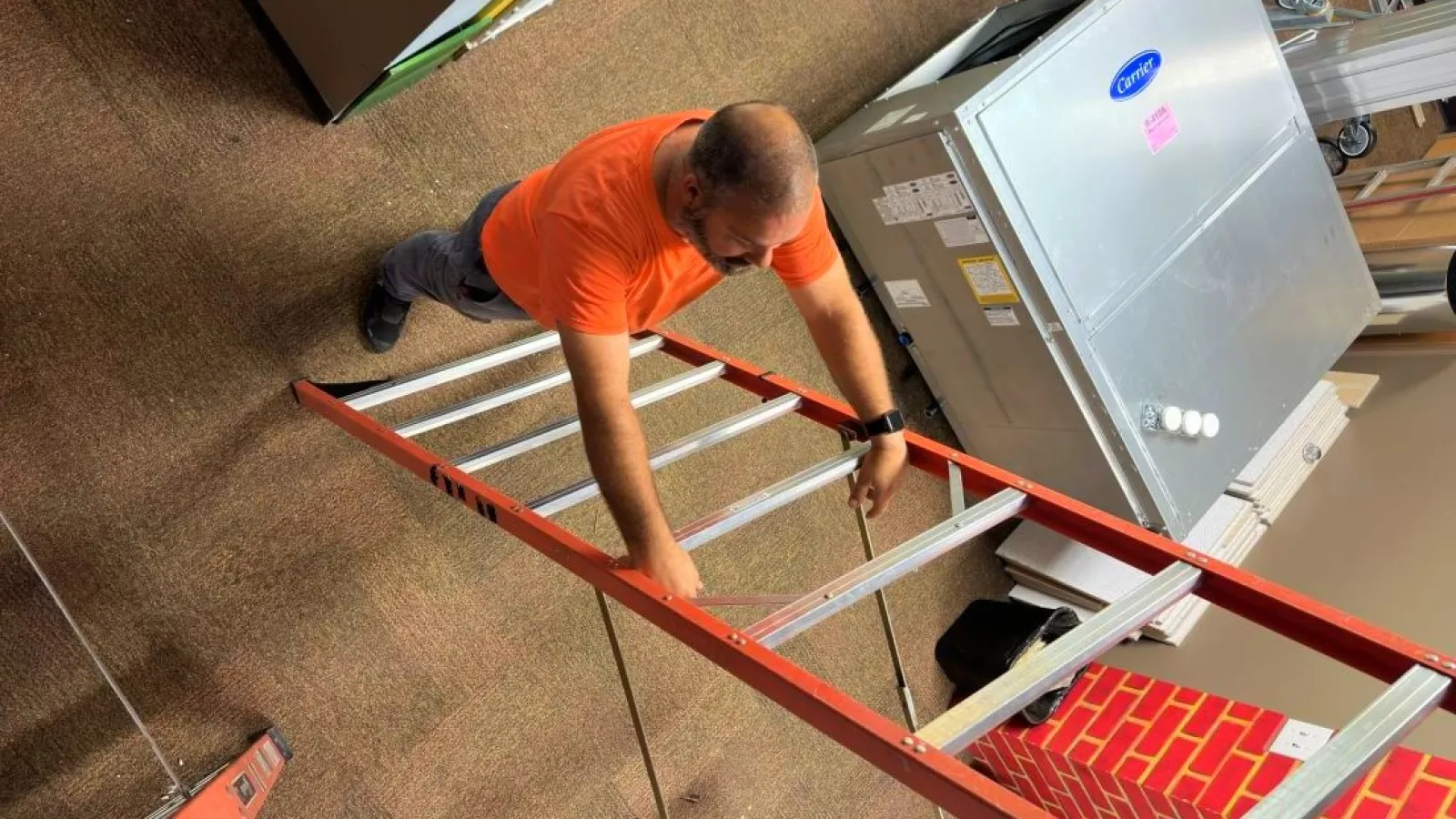In this blog, we’ll review a recent project which required the upgrade of a commercial HVAC control system for a longtime customer.
Type of Facility and Function
The facility serves as a living, work, and worship center for up to 137 people to sleep, eat, socialize, work, and worship. During the day workers tend to different facility operation tasks as well as sort and distribute donations of household goods and clothing.
Age of Structure and HVAC System Situation
Originally built in 1974, the building’s original HVAC system centered around a Commercial Chilled Water and Hot Water Cooling and Heating system with 8 Air Handling Units spread throughout the facility.
Five of these Air Handling Units were the Hot Deck/Cold Deck Multi-Zone Type. Great for their time, they provided superior comfort with both hot and cold air at the same time which allows zones to both heat and cool simultaneously.
Unfortunately, they’re now considered highly inefficient because a typical unit supplies both 55-degree cooling air and 100-degree heating air to all of the zones. The zones use a mixing damper to mix the two air streams together to achieve a 55-100 degree supply air temperature in the zone. Hot Deck/Cold Deck multi-zone units became unpopular due to inefficiency and the 1970’s oil crisis.
Original Type of Controls: Pneumatic Controls
Pneumatic Controls use compressed air to control and operate actuators which open and close dampers and valves throughout the HVAC system at varying pressure. The pressure depends on the temperature sensors.
For their time, pneumatic controls performed okay with moderate accuracy. Unfortunately, technology left them behind and they ultimately contributed to the inefficiency of the HVAC system.
Owner Replaces Original System
In 2005 the building owner replaced the entire HVAC system of the building but was limited by the original HVAC system designs. The new HVAC equipment, therefore, was built around the Chilled Water/Hot Water, Hot Deck/Cold Deck arrangement. The equipment improved but the design concept continued to be a source of inefficiency.
Improvements Included New HVAC Control System and RTUs
One major improvement, however, was the replacement of the original Pneumatic Control system with a new Andover DDC Control System. The DDC system provided much better system efficiency, accuracy, and user-friendly adjustments.
It still lacked energy efficiency because it couldn’t communicate with the different system components and adjust the supply water and air temperatures based on building demands.
In addition, four new traditional Rooftop Package Units (RTUs) were installed in newer sections of the building and connected to the Andover Controls System.
Estes Takes Over Commercial HVAC Repairs and Service
After expressing disappointment with the 2005 HVAC contractor, the organization began working with Estes Commercial in 2009. Eventually, Estes Commercial’s dedication and responsiveness convinced the organization to include all the buildings under their control.
January 2018 – Air Handlers and Andover Controls Fail
One January morning greeted the residents without heat in the kitchen, dining hall, and social hall.
The organization chose to upgrade the controller for the failed Air Handling Unit to a new Honeywell Eagle-AX Controller. An easy choice, the Andover system was out of date, proprietary and did not offer advanced energy saving capabilities.
Comfort returned once Estes installed the new Eagle-AX controller in the Kitchen, Dining Room, and Social Hall areas. Estes Commercial installed this original Eagle-AX controller as its own independent control system with its own User Interface hosted by the controller itself.
In March another Air Handling Unit over some of the living quarters suddenly broke down. Once again, the issue was the failing Andover Controls. Within a week another controller serving another air handler started having problems. It became clear the Andover system was quickly failing all over the building.
An entire system upgrade was needed but the funds were not immediately available. So, to keep the facility operational each failed controller was strategically replaced one at a time to keep the building operational.
Funds Available to Upgrade Whole Commercial HVAC Control System
Finally, in October the funds became available. It was time to replace all the remaining Andover Controls and to connect the new Honeywell controls.
Replacing all of the controls with new technology allowed the system to remain operational. The user-friendly graphics and interface also increased ease of use for the customer.
In addition, it allowed Estes Commercial to implement more complex control schemes, such as linking all of the units together. As the systems began to operate together, they provided better building comfort and made great leaps in energy efficiency.
The more conservative water temperature setpoints allowed the chiller and boiler to operate more energy efficiently. Secondly, it allowed the water side economizer to operate more frequently during mild weather conditions. This further reduced energy consumption. Very important to a nonprofit!
Thanks to the new controls, the central building plant and the Hot Deck/Cold Deck Air Handling Units operate more energy efficiently.
Instead of supplying 55 and 100-degree air streams at all times the units vary the cold deck temperature from 75 to 55 degrees and the hot deck temperatures from 75 to 100 degrees depending on zone comfort demands.
Additional Benefits from the Streamlined Control System
This allowed more efficient operation of the Air Handling Units themselves as well as reduced demands on the central plant. This allows it to also adjust to more conservative settings when the zones are comfortable.
Estes Commercial decided the best way to control each group of units was to combine them and use one controller.
The amount of I/O needed was more than a typical Unitary controller handles so Estes recommended an Eagle-AX controller instead. With this controller, the two units work together off of one temperature and one setpoint to comfort the space.
The two units also worked in a lead/lag arrangement with changeover based on unit runtime. This meant one unit was not always coming on first or doing all of the work. Instead the two units take turns allowing equal runtime and work between the two units. This prevents one unit from wearing out before the other.
Results: Upgrade of Commercial HVAC Control System Drastically Improved Comfort, Performance and Energy Bills
The nonprofit organization originally chose to replace the controls system due to the rapid failures of the old and existing Andover Control System.
The prospects of better system management through a more user-friendly, graphic user interface were the main factors in the decision to replace the system. The remote access also allows Estes to help manage the system remotely at any time.
“While we thought energy savings might be a result of the system upgrade, we really didn’t expect much because our facility operates 24/7 and leaves no real potential for setbacks or savings.
Keeping the facility operational was the key factor in making our decision to upgrade the commercial HVAC control system. What we found afterward was better system control than ever before and we were a lot more comfortable. Energy savings experienced from the system is a big plus,” said the client.
The improved facility comfort came as a result of equipment optimization and the HVAC systems and controls communicating together and operating as a team.
If you’re interested in a commercial HVAC control system or building automation, contact the experts at Estes Commercial. Our team carefully evaluates each situation and provides options for heating, cooling, ventilation, and indoor air quality. We also customize commercial HVAC preventive maintenance plans to save you time and money. Call Estes Commercial today!


